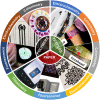Flexible Biosensors Based on Colorimetry, Fluorescence, and Electrochemistry for Point-of-Care Testing
- PMID: 34650963
- PMCID: PMC8505690
- DOI: 10.3389/fbioe.2021.753692
Flexible Biosensors Based on Colorimetry, Fluorescence, and Electrochemistry for Point-of-Care Testing
Erratum in
-
Corrigendum: Flexible biosensors based on colorimetry, fluorescence, and electrochemistry for point-of-care testing.Front Bioeng Biotechnol. 2022 Nov 15;10:1087738. doi: 10.3389/fbioe.2022.1087738. eCollection 2022. Front Bioeng Biotechnol. 2022. PMID: 36457856 Free PMC article.
Abstract
With the outbreak and pandemic of COVID-19, point-of-care testing (POCT) systems have been attracted much attention due to their significant advantages of small batches of samples, user-friendliness, easy-to-use and simple detection. Among them, flexible biosensors show practical significance as their outstanding properties in terms of flexibility, portability, and high efficiency, which provide great convenience for users. To construct highly functional flexible biosensors, abundant kinds of polymers substrates have been modified with sufficient properties to address certain needs. Paper-based biosensors gain considerable attention as well, owing to their foldability, lightweight and adaptability. The other important flexible biosensor employs textiles as substrate materials, which has a promising prospect in the area of intelligent wearable devices. In this feature article, we performed a comprehensive review about the applications of flexible biosensors based on the classification of substrate materials (polymers, paper and textiles), and illustrated the strategies to design effective and artificial sensing platforms, including colorimetry, fluorescence, and electrochemistry. It is demonstrated that flexible biosensors play a prominent role in medical diagnosis, prognosis, and healthcare.
Keywords: flexible biosensor; paper; point-of-care testing; polymer; textile.
Copyright © 2021 Yan, Zhang, Chai, Qu and Zhang.
Conflict of interest statement
The authors declare that the research was conducted in the absence of any commercial or financial relationships that could be construed as a potential conflict of interest.
Figures



Similar articles
-
Flexible electrochemical biosensors for healthcare monitoring.J Mater Chem B. 2020 Aug 26;8(33):7303-7318. doi: 10.1039/d0tb01325k. J Mater Chem B. 2020. PMID: 32647855 Review.
-
Flexible plastic, paper and textile lab-on-a chip platforms for electrochemical biosensing.Lab Chip. 2018 Jun 26;18(13):1812-1830. doi: 10.1039/c8lc00025e. Lab Chip. 2018. PMID: 29855637 Review.
-
Corrigendum: Flexible biosensors based on colorimetry, fluorescence, and electrochemistry for point-of-care testing.Front Bioeng Biotechnol. 2022 Nov 15;10:1087738. doi: 10.3389/fbioe.2022.1087738. eCollection 2022. Front Bioeng Biotechnol. 2022. PMID: 36457856 Free PMC article.
-
Functionalized Organic Thin Film Transistors for Biosensing.Acc Chem Res. 2019 Feb 19;52(2):277-287. doi: 10.1021/acs.accounts.8b00448. Epub 2019 Jan 8. Acc Chem Res. 2019. PMID: 30620566 Review.
-
Flexible Point-of-Care Electrodes for Ultrasensitive Detection of Bladder Tumor-Relevant miRNA in Urine.Anal Chem. 2023 Jan 6. doi: 10.1021/acs.analchem.2c03156. Online ahead of print. Anal Chem. 2023. PMID: 36607132
Cited by
-
Sensors and Devices Guided by Artificial Intelligence for Personalized Pain Medicine.Cyborg Bionic Syst. 2024 Sep 13;5:0160. doi: 10.34133/cbsystems.0160. eCollection 2024. Cyborg Bionic Syst. 2024. PMID: 39282019 Free PMC article. Review.
-
Coupled Gold Nanoparticles with Aptamers Colorimetry for Detection of Amoxicillin in Human Breast Milk Based on Image Preprocessing and BP-ANN.Foods. 2022 Dec 19;11(24):4101. doi: 10.3390/foods11244101. Foods. 2022. PMID: 36553847 Free PMC article.
-
Advances in the use of nanomaterials for nucleic acid detection in point-of-care testing devices: A review.Front Bioeng Biotechnol. 2022 Oct 13;10:1020444. doi: 10.3389/fbioe.2022.1020444. eCollection 2022. Front Bioeng Biotechnol. 2022. PMID: 36312553 Free PMC article. Review.
-
Sensing of Catecholamine in Human Urine Using a Simple Colorimetric Assay Based on Direct Melanochrome and Indolequinone Formation.Sensors (Basel). 2023 Apr 13;23(8):3971. doi: 10.3390/s23083971. Sensors (Basel). 2023. PMID: 37112313 Free PMC article.
-
Quantitative Colorimetric Sensing of Carbidopa in Anti-Parkinson Drugs Based on Selective Reaction with Indole-3-Carbaldehyde.Sensors (Basel). 2023 Nov 13;23(22):9142. doi: 10.3390/s23229142. Sensors (Basel). 2023. PMID: 38005530 Free PMC article.
References
-
- Andrysiewicz W., Krzeminski J., Skarżynski K., Marszalek K., Sloma M., Rydosz A. (2020). Flexible Gas Sensor Printed on a Polymer Substrate for Sub-ppm Acetone Detection. Electron. Mater. Lett. 16, 146–155. 10.1007/s13391-020-00199-z - DOI
Publication types
LinkOut - more resources
Full Text Sources

